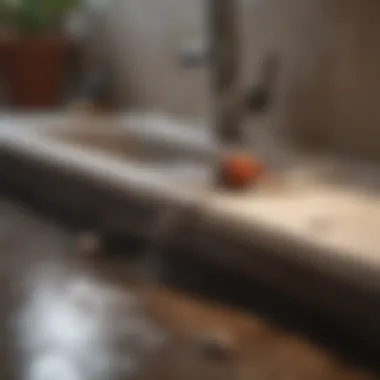Homemade Drain Unclogger: Natural Solutions Guide


Intro
Clogs in drains can be a common and frustrating issue. Understanding how to tackle these problems effectively is essential. There are several advanced and simple methods to address clogged drains. This guide will explore how to use natural ingredients to unclog drains, the processes involved, and the preventative steps you can take to avoid future blockages. Knowing these solutions helps you maintain a well-functioning plumbing system, while also being mindful of the environment.
Homemade unclogging strategies are not just practical but often more cost-effective than calling a professional. Moreover, being informed about the right approach can save time and resources. This article aims to provide you with clear, actionable information that combines effectiveness with eco-friendliness.
The solutions discussed here will be applicable to different types of plumbing systems and a variety of clog situations. Whether it is a simple kitchen sink blockage or a more serious issue in the bathroom, you will find various methods tailored to your needs.
Safety is a key consideration when dealing with clogged drains. Understanding how to use these homemade solutions without harming yourself or your plumbing system is vital. With this knowledge, you can approach drain cleaning confidently, knowing the limits of homemade remedies and when a professional should be called.
In the following sections, we will delve deep into the specific homemade solutions and techniques for unclogging drains and maintaining clear plumbing.
Foreword to Drain Clogs
Understanding drain clogs is essential for any homeowner. Clogs can lead to a range of problems, from slow draining water to serious plumbing issues which often require professional intervention. Moreover, addressing drain issues promptly can save money and prevent more significant damage to your plumbing system.
Understanding the Causes of Clogs
Clogs often occur due to a buildup of materials in the pipes. Common culprits include hair, grease, soap residue, and food particles. Over time, these substances accumulate and create blockages. In kitchen sinks, grease is a frequent offender. In contrast, bathrooms tend to have more hair and soap buildup. Environmental factors, such as tree roots infiltrating underground pipes, can also lead to significant clogs. Knowing these causes helps in both prevention and effective cleaning when necessary.
The Importance of Drain Maintenance
Regular drain maintenance plays a crucial role in preventing clogs. Simple routines, like running hot water through drains and using strainers in sinks, can make a difference. It is also beneficial to inspect your drains periodically for signs of trouble. Investing some time in maintenance reduces the likelihood of clogs. Simple homemade solutions can be employed to maintain clear drains. This proactive approach not only keeps the plumbing system functioning properly but also extends its life, ultimately benefiting homeowners.
Common Homemade Ingredients
The use of common homemade ingredients for unclogging drains is both practical and cost-effective. Traditional methods of plumbing repair can be expensive, and often involve harsh chemicals that may be harmful to both the environment and your plumbing system. Using simple kitchen staples not only offers a solution but also promotes a healthier home by avoiding unwanted additives.
Natural ingredients like baking soda, vinegar, salt, and hot water provide several benefits. They often have dual roles, functioning as both cleaning agents and preventative measures against future clogs. These substances are readily available and present a minimal risk when used properly.
Additionally, understanding how these ingredients interact helps maximize their effectiveness. The reactions between them may create strong cleaning solutions without needing specialized equipment. This overall approach aligns well with sustainable living, supporting the notion of reducing waste while maintaining a functional home. With that context in place, let's delve deeper into each ingredient.
Baking Soda: An Effective Agent
Baking soda is often regarded as a go-to remedy for many household cleaning tasks, and its ability to unclog drains is no exception. When combined with an acid, such as vinegar, it generates a fizzing reaction. This action can help dislodge debris and break down stubborn clogs. The alkaline nature of baking soda also assists in neutralizing odors in drains.
To use baking soda for unclogging purposes, simply measure about half a cup and pour it down the drain. This should be followed by a generous amount of hot water after letting it sit for around 15 minutes. This method can be effective for minor clogs resulting from food particles or grease.
Vinegar: The Foaming Companion
Vinegar, particularly white vinegar, is another staple that shines in its unclogging capabilities. This acidic liquid is a perfect match for baking soda. The combination of the two creates a foaming action that effectively breaks up clogs. Moreover, vinegar has antibacterial properties that can help eliminate buildup caused by harmful bacteria.
To utilize vinegar, pour one cup down the drain after the baking soda. Wait for at least 30 minutes before flushing with hot water. This not only helps clear existing clogs but also aids in future prevention by cleaning the pipes.
Salt: A Natural Abrasive
Salt can serve multiple purposes in your drain maintenance routine. As a natural abrasive, it effectively scrubbs the walls of pipes and helps eliminate build-up. Furthermore, when mixed with boiling water, salt enhances the unclogging effect which can be particularly useful for more stubborn blockages.
To use salt for unclogging, pour half a cup down the drain followed by boiling water. Allowing it to sit for a while before flushing will maximize its effectiveness.
Hot Water: A Simple Solution
Sometimes, the simplest solution is the best solution. Hot water alone can be an efficient way to flush out minor clogs. It helps dissolve grease and soap residues that often contribute to drain blockages. The key is to use water that is just off the boil, as water that is too hot might damage some pipe materials.
To implement this method, carefully pour hot water directly into the drain. In cases where grease is suspected to be the culprit, repeating the process multiple times may yield better results.


In summary, utilizing common homemade ingredients like baking soda, vinegar, salt, and hot water presents an effective and eco-friendly approach to unclogging drains. These remedies are not only accessible but also encourage sustainable practices in home maintenance.
Step-by-Step Unclogging Methods
Unclogging drains can be a frustrating experience. However, knowing how to apply specific methods can make the process more manageable. This section provides practical insight into several effective homemade techniques to clear clogged drains. The goal is to empower readers with knowledge about these methods, considering factors like cost-effectiveness and environmental impact.
Using Baking Soda and Vinegar
Baking soda and vinegar is a classic combination known for its effectiveness in unclogging drains. Here's how it works:
- Preparation: Start by removing any visible debris from the drain. This could be hair or food particles.
- Adding Baking Soda: Pour about half a cup of baking soda directly into the drain. The alkaline nature of baking soda helps to break down waste.
- Vinegar Reaction: After adding the baking soda, follow it with half a cup of vinegar. This will create a chemical reaction that can loosen more stubborn clogs.
- Covering the Drain: Place a cloth or a stopper over the drain. This helps maintain the reaction inside the pipe.
- Wait: Allow it to sit for about 30 minutes. For tough clogs, leaving it longer can be more beneficial.
- Flush with Hot Water: Finish by flushing the drain with hot water to wash away the loosened debris.
The effervescent reaction between baking soda and vinegar can clear many common clogs due to the unclogging effect and the natural deodorizing properties.
Salt and Hot Water Combination
Salt is another ingredient that can aid in unclogging, especially when paired with hot water. It acts as an abrasive that can help break down buildup in pipes. Here’s the method:
- Measure Ingredients: Use one cup of salt and heat up two cups of water until boiling.
- Pouring Salt: First, pour the salt directly into the drain. Salt can help absorb moisture and draw out any substances causing clogs.
- Adding Hot Water: Follow the salt with the hot water. This will help dissolve grease or organic materials causing the blockage.
- Repetition: If necessary, repeat this process a couple of times. Frequent usage can prevent future clogs.
This method is especially useful for kitchen drains, which often deal with greasy buildups.
Creating a Baking Soda and Salt Mixture
Another potent combination involves mixing baking soda with salt. Salt enhances the abrasive quality of baking soda. Here’s how to use this mixture:
- Mix Ingredients: Combine one cup of baking soda with one cup of salt in a bowl.
- Application: Pour the mixture down the clogged drain.
- Follow with Water: After the mixture has settled, wait about 10 minutes and then flush the drain with boiling water.
- Effectiveness: This method works well for clogs that are tough but not fully blocked, allowing for some drainage.
By combining these two substances, you can achieve a more thorough cleaning effect.
Plunger Techniques for Homemade Solutions
While chemical methods can be effective, sometimes a physical approach is necessary. Here’s how to use a plunger effectively:
- Choose the Right Plunger: Use a cup plunger for sinks and a flange plunger for toilets.
- Creating a Seal: Ensure the plunger covers the drain completely to create a vacuum.
- Pumping Technique: Push down and pull up sharply and repeatedly. The pressure can help dislodge the clog. Keep the movement steady and controlled.
- Check for Success: After a few minutes, check if the water drains. If it does, you've cleared the obstruction.
- Repeat if Needed: If the clog persists, repeat the process a few more times.
A plunger can be a straightforward tool in your unclogging process. Its efficacy lies in its ability to utilize air pressure to remove blockages.
Using homemade methods to unclog your drains can reduce the need for harsh chemicals, making it a safer choice for your plumbing and the environment.
Evaluating Effectiveness
Evaluating the effectiveness of homemade drain uncloggers is crucial. Understanding how well a solution works helps in decision-making processes. By recognizing the right remedies for specific types of clogs, you can save time and resources. This section will discuss various essential points about evaluation, including types of clogs, appropriate application times, and the limitations of these remedies.
Types of Clogs and Corresponding Solutions
Not all clogs are created equal. The nature of the blockage affects how to approach it. Here are some common types of clogs:
- Hair clogs: Often found in bathrooms, hair can be removed with a mixture of baking soda and vinegar. Both ingredients break down organic material.
- Grease clogs: Found in kitchen sinks, grease requires hot water mixed with salt. The salt acts as an abrasive that helps dislodge the buildup.
- Food particles: Also common in kitchen drains, a combination of baking soda and vinegar works. This method utilizes the foaming action to push particles through.
Each type of clog necessitates a tailored solution. Review the blockage and choose a method accordingly.
When to Apply Homemade Uncloggers
Timing plays an essential role in using homemade uncloggers effectively. Here are some guidelines to consider:


- Use unclogging solutions at the first signs of slow drainage. Delaying treatment may lead to more severe clogs.
- After heavy cooking, consider a hot water flush to prevent grease build-up.
- Regular maintenance, such as monthly vinegar and baking soda treatments, can prevent future issues.
Identifying the right moment can make a significant difference in maintaining optimal drain function.
Limitations of Homemade Remedies
While homemade solutions can be effective, they do have limitations. Being aware of these can help manage expectations and conserve efforts:
- Not effective for all clogs: Some severe blockages, like structural issues or tree roots, require a professional's intervention.
- Temporary results: Homemade remedies may provide short-term fixes but won't resolve underlying problems.
- Risk of damage: Certain ingredients, if misused, can harm plumbing systems. Always follow recommended guidelines.
It’s important to recognize that while these methods can be helpful, sometimes seeking professional help is necessary for persistent or complex issues.
In summary, evaluating the effectiveness of homemade drain uncloggers is key to proper use. Understanding the types of clogs and when to apply certain remedies is beneficial. Yet, it is equally vital to acknowledge the limitations to avoid frustration.
Preventative Measures
Preventing drain clogs is essential for maintaining the overall functionality of plumbing systems. This section focuses on several specific elements that can help avoid the hassle of dealing with clogged drains. Implementing these measures not only saves time but also expenses associated with professional plumbing services.
Regular Cleaning Routines
Establishing regular cleaning routines for drains is crucial. This involves cleaning sink drains, shower drains, and toilets on a consistent schedule. People should consider a thorough cleaning at least once a month. Simple methods like flushing with hot water or using vinegar can effectively dissolve minor buildup.
When cleaning, ensure to remove any visible debris to avoid accumulation. For more stubborn obstructions, a mixture of baking soda and vinegar can work wonders.
Benefits of regular cleaning include:
- Reduces the chances of clogs.
- Maintains a fresh smell in the environment.
- Minimizes the need for extensive unclogging measures.
Utilizing Drain Strainers
The use of drain strainers is a reliable method to prevent larger debris from entering the plumbing system. These inexpensive devices catch hair, food particles, and other solids, ensuring that only liquid waste goes down the drain.
When selecting a drain strainer, consider the size and material. Stainless steel strainers are durable and easy to clean.
Key points to consider:
- Strainers should be cleaned regularly to avoid buildup.
- Proper fitting is essential for maximizing effectiveness.
- Using strainers is a proactive step towards maintaining clear drains.
Educating Household Members
Education is a powerful tool in preventing drain clogs. All household members should understand what items can and cannot go down the drains.
Informing them about simple dos and don’ts can drastically reduce the risk of clogs. For example, items like grease, food scraps, and non-biodegradable materials should be disposed of in the trash rather than down the sink or toilet.
Consider implementing a simple guideline:
- Create easy-to-read posters to place near sinks and toilets that outline proper waste disposal methods.
- Encourage children to learn and participate in maintaining the home's plumbing health.
Ultimately, a collective effort from all household members contributes significantly to the durability of the plumbing system. Maintaining clear drains ensures comfort and functionality in the home.
Safety Considerations
Safety is paramount when dealing with drain unclogging methods, especially when using homemade solutions. Many natural ingredients, while effective, can pose risks if not handled properly. Understanding these safety considerations helps prevent accidents and ensures that the unclogging process is not only successful but also safe.
Protective Gear Recommendations


When engaging in any unclogging process, wearing protective gear is wise. Here are some essential items to consider:
- Gloves: Use rubber gloves to protect your hands from chemicals and potential irritants. This is crucial when handling substances like vinegar or baking soda, which can cause skin irritation in some individuals.
- Safety Goggles: Protect your eyes from splashes. While the risk is lower with natural ingredients, it's still better to be cautious.
- Face Mask: If you are concerned about inhaling dusty residues from baking soda or other ingredients, a mask can minimize your exposure.
These items are simple to use but can significantly enhance your safety during the process.
Handling Emergency Situations
Sometimes, despite our best efforts, situations can escalate. Knowing how to respond in emergencies ensures you can manage issues effectively.
- Recognize Signs of Serious Clogs: If you notice backing water or unusual sounds from the pipes, it is important to act quickly. Do not ignore these signs, as they may indicate a more severe plumbing issue.
- Avoid Chemical Mixes: Mixing different household cleaners, particularly with vinegar or bleach, can create harmful gases. Always research before combining substances and stick to the recommended methods.
- Know When to Call a Professional: If DIY methods fail or if the situation worsens, don’t hesitate to contact a plumber. Certain drain issues require specialized tools and knowledge, and recognizing these limits is crucial for maintaining plumbing health.
Important: Safety during home maintenance is not just about protecting oneself; it is about ensuring the whole environment remains safe for all household members during the unclogging process.
By following these safety considerations and recommendations, you can approach drain unclogging with confidence and minimize potential risks.
When to Seek Professional Help
Sometimes, despite the strongest efforts with homemade methods, drain clogs persist. Knowing when to seek help from a professional is essential in maintaining a functional plumbing system. This section discusses how to identify serious drain issues and evaluates the cost-effectiveness of choosing DIY solutions versus hiring experts.
Identifying Serious Drain Issues
Certain symptoms indicate a problem may require professional attention. If you notice recurrent clogs despite attempts to clear them, this may suggest a deeper issue within the plumbing system. Other signs include:
- Slow Drains: If multiple fixtures drain slowly at the same time, it could signify a major blockage deep within the plumbing.
- Foul Odors: Unpleasant smells can indicate stagnant water or decaying matter in the pipes.
- Water Backups: If water backs up into sinks or tubs when using other fixtures, a significant blockage could exist.
- Gurgling Noises: Sounds emanating from your drains can signify air trapped by blockages.
Recognizing these indicators early can prevent further damage and expensive repairs. Trust your instincts—if the situation feels beyond your skill level, it is best to consult a professional.
Assessing the Cost-Benefit of DIY Versus Professional Services
Choosing between DIY methods and professional services requires a careful assessment of costs and potential benefits. On one hand, homemade solutions can be economical, using simple ingredients like baking soda, vinegar, and hot water. These options are environmentally friendly and may solve minor clogs effectively.
However, consider the following factors:
- Severity of the Problem: If the clog is serious, DIY methods may not reach the root cause, leading to recurring problems and further costs.
- Time Investment: Attempting multiple DIY methods may consume valuable time that could otherwise be spent on other aspects of home maintenance.
- Potential Damage: Incorrect usage of homemade remedies can sometimes worsen the situation, leading to additional costs.
In contrast, hiring a professional may incur higher upfront costs but can result in long-term savings by addressing the issue correctly. Professionals often have tools and expertise to identify and resolve the problem effectively, ensuring your plumbing operates smoothly.
In summary, while DIY solutions may work for simpler problems, serious drain issues often necessitate the expertise of professionals. Knowing when to recognize your limits is key in maintaining an efficient plumbing system.
Ultimately, balancing the desire to save money with the need for effective solutions is crucial. Keep these considerations in mind, and you will make informed decisions that benefit both your plumbing and finances.
Closure and Summary
In reviewing the topic of homemade drain unclogging methods, it becomes evident that understanding this area is crucial for both maintaining an effective drainage system and promoting eco-friendly practices within our homes. Homemade solutions often present a practical and less chemically intensive alternative to commercial products. They empower homeowners by providing cost-effective options that utilize common household items. This approach aligns with growing concerns regarding environmental footprints and the promotion of sustainable living.
Recap of Homemade Unclogging Solutions
Throughout this guide, we explored natural ingredients that serve as effective remedies for clearing drain clogs. Baking soda, vinegar, salt, and hot water emerged as potent tools, capable of addressing many minor obstructions. Each method offered a direct, accessible solution that can easily be implemented, while also enriching our understanding of how such combinations work in tandem to dissolve buildup.
- Baking Soda: This acts as a powerful agent for breaking down grease and organic matters.
- Vinegar: When combined with baking soda, it creates a foaming reaction that can dislodge stubborn clogs.
- Salt: A natural abrasive that can help scrub potential blockages, particularly when used with hot water.
- Hot Water: This simple yet effective solution aids in melting away grease and grime.
These methods emphasize the significance of early intervention with clogs, mitigating the need for more drastic measures. Furthermore, understanding the chemical reactions between these ingredients not only adds to their usability but also enhances their effectiveness in different situations.
Final Thoughts on Drain Maintenance
Maintaining clear drains is more than just occasional unclogging; it requires a commitment to consistent care practices. Implementing regular cleaning routines, using drain strainers, and educating all household members about what can and cannot be disposed of through drains are critical steps. These efforts not only prevent clogs but also extend the lifespan of plumbing systems.
In summary, knowing how to effectively manage drain issues using homemade remedies not only equips homeowners with skills to tackle everyday problems but also aligns with a broader commitment to sustainability. When considering the balance between DIY approaches and the potential need for professional interventions, it is essential to recognize the limitations of homemade methods. This awareness allows for informed decisions, making it easier to determine the right course of action when faced with persistent or severe plumbing issues.
"An ounce of prevention is worth a pound of cure." By prioritizing maintenance, the likelihood of facing more complex drainage problems can be significantly reduced.















